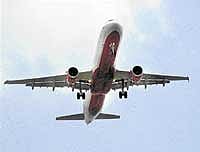

The AIE flight from Dubai to Pune on May 26, four days after the deadly Mangalore crash, was just seconds away from ramming another plane in airspace near Kuwait.
The AIE IX-212, carrying 112 passengers, would have ended up in a mid-air collision as the commander had gone out of the cockpit to the toilet and when he rushed back, could not open the cockpit door as the co-pilot was either busy in the controls or had just “blanked out”.
Because of security precaution, the cockpit door can only be opened from inside or through punching security code from outside. In the last week’s incident, the standard operating procedure (SOP) was not followed as the cabin crew (who could have opened the cockpit door) was not inside.
According to informed sources, the Boeing 737-800 (similar to the one involved in Mangalore) dropped height an hour after takeoff and lost some 6,000 feet in three minutes. The Muscat Air Traffic Control was said to have noticed the drop and alerted AIE flight to climb to 37,000 feet to avoid collision with the other aircraft.
As per one version, the co-pilot could not open the door, though the commander was banging on it from outside, as he was busy at the controls and eventually managed to steady the plane.
Another version says the co-pilot had “blanked out” when the flight commander took a break.
The commander, when he returned to the controls, found the autopilot disengaged and saw the co-pilot unable to bring the plane under control.
‘No real danger’
He (the commander) reportedly brought the plane in to the manual mode immediately .
Officials, however, said there was no real danger of a collision as the anti-collision device, called Traffic collision avoidance system (TCAS) in aviation parlance, would have come into operation alerting the pilots.
The scary incident is now under investigation. The Air India has already derostered the pilots but denied any one was hurt.
Related stories
Only 8 out of 42 tipsy pilots sacked
